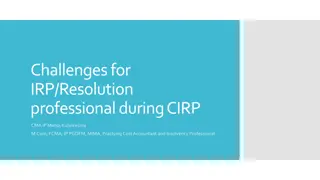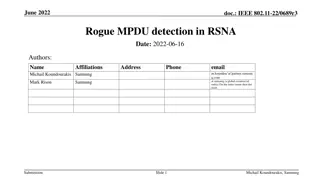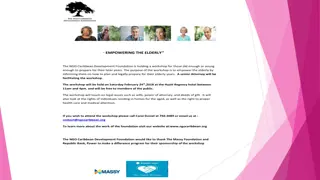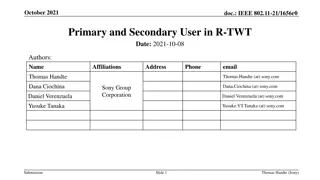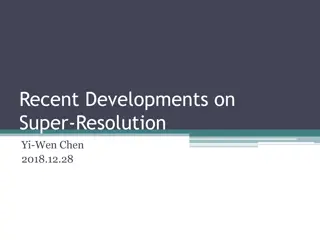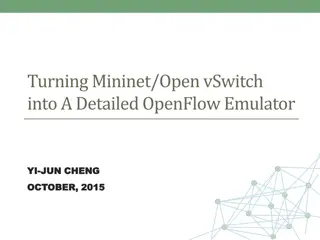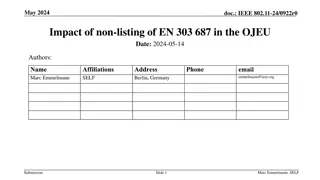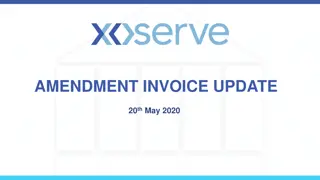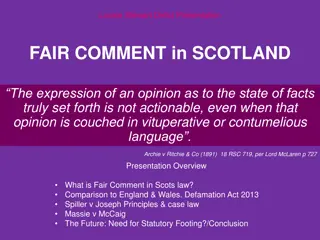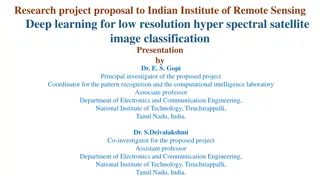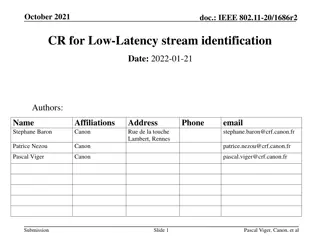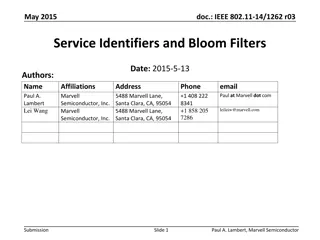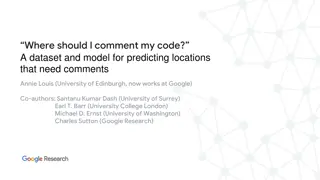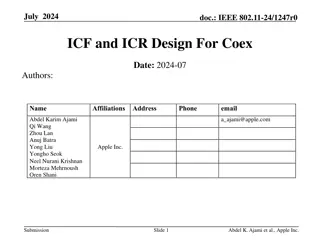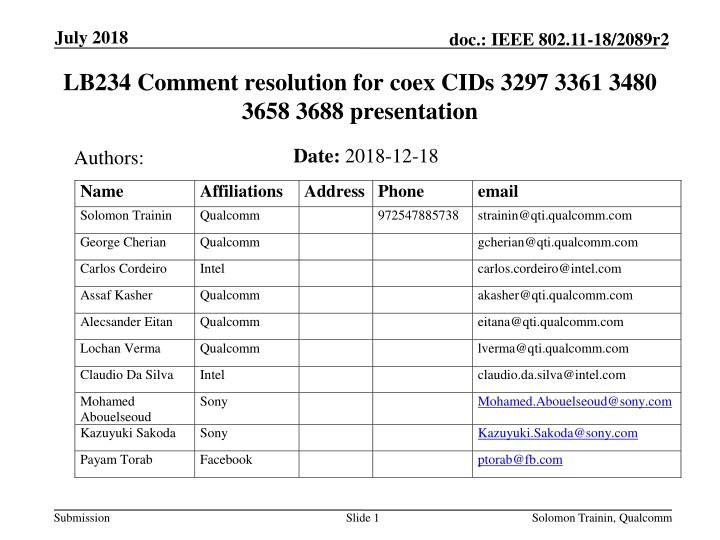
IEEE 802.11-18/2089r2 Resolution of Coexistence CIDs Presentation
"Learn about the resolution of critical Coexistence Identifiers (CIDs) 3297, 3361, 3480, 3658, and 3688 as presented in the July 2018 document for IEEE 802.11-18/2089r2. Explore topics like beaconing roles, DMG STA parameters, and alternative beaconing procedures in network management. Stay informed with the latest proposals and elements in DMG beacon format and transmission. Get insights from industry experts at Qualcomm, Intel, Sony, and more. Join the discussion on enhancing network performance and efficiency."
Download Presentation

Please find below an Image/Link to download the presentation.
The content on the website is provided AS IS for your information and personal use only. It may not be sold, licensed, or shared on other websites without obtaining consent from the author. If you encounter any issues during the download, it is possible that the publisher has removed the file from their server.
You are allowed to download the files provided on this website for personal or commercial use, subject to the condition that they are used lawfully. All files are the property of their respective owners.
The content on the website is provided AS IS for your information and personal use only. It may not be sold, licensed, or shared on other websites without obtaining consent from the author.
E N D
Presentation Transcript
July 2018 doc.: IEEE 802.11-18/2089r2 LB234 Comment resolution for coex CIDs 3297 3361 3480 3658 3688 presentation Date: 2018-12-18 Authors: Name Solomon Trainin Affiliations Qualcomm Address Phone email strainin@qti.qualcomm.com 972547885738 George Cherian Qualcomm gcherian@qti.qualcomm.com Carlos Cordeiro Intel carlos.cordeiro@intel.com Assaf Kasher Qualcomm akasher@qti.qualcomm.com Alecsander Eitan Qualcomm eitana@qti.qualcomm.com Lochan Verma Qualcomm lverma@qti.qualcomm.com Claudio Da Silva Intel claudio.da.silva@intel.com Mohamed Abouelseoud Kazuyuki Sakoda Sony Mohamed.Abouelseoud@sony.com Sony Kazuyuki.Sakoda@sony.com Payam Torab Facebook ptorab@fb.com Submission Slide 1 Solomon Trainin, Qualcomm
July 2018 doc.: IEEE 802.11-18/2089r2 Abstract Resolution of CIDs 3297, 3361, 3480, 3658, and 3688 is presented. Submission Slide 2 Solomon Trainin, Qualcomm
July 2018 doc.: IEEE 802.11-18/2089r2 Beaconing role Make known of the presence of the network Network Management: Scan, Neighbor report DMG beamforming BTI, A-BFT, ATI/DTI Submission Slide 3 Solomon Trainin, Qualcomm
July 2018 doc.: IEEE 802.11-18/2089r2 Proposal DMG Beacon format The beacon PPDU contains RX TRN s The TDD slot structure and the TDD slot schedule elements are optionally presented in the beacon Presence of the Extended schedule element is mandatory New IE DMG STA Tx Power and Rx Sensitivity parameters element is introduced to be conveyed in the DMG Beacon Submission Slide 4 Solomon Trainin, Qualcomm
July 2018 doc.: IEEE 802.11-18/2089r2 Proposal (continuation) Alternative beaconing procedure One DMG beacon frame is transmitted per each Tx antenna configuration that is established to communicate with the associated STA Submission Slide 5 Solomon Trainin, Qualcomm
July 2018 doc.: IEEE 802.11-18/2089r2 DMG STA parameters Element ID Length Element ID Extension TRP G_ADD_SENS Octets: 1 1 1 1 1 TRP Total Radiated Power G_ADD_SENS Gain due to receiver s additional sensitivity G_ADD_SENS = Pmin_sensitivity-Psensitivity where Pmin_sensitivity is the receiver sensitivity for MCS 0 defined in Table 20-3, Psensitivity is the actual PCP or AP receiver sensitivity Figure xy DMG STA Tx Power and Rx Sensitivity parameters element format Submission Slide 6 Solomon Trainin, Qualcomm
July 2018 doc.: IEEE 802.11-18/2089r2 HOW TRP, G_ADD_SENS and TRN field may be used When a STA receives a beacon from the AP, its measured receive power is ??? When the AP receives a PPDU from this STA, using the same antenna configuration ??? Substituting ??? pattern reciprocity) We have that the STA should maintain P to make sure it doesn t create interference at the AP. (Note that All the elements on the right-hand side are known to the STA) ???= ?????+ ??? ???? ??? ???????? + ??? ???? ???????? + ??? ??? ????? ??? ??= ??????+ ??? ??? ???????? = ??? ??? ???? (Assuming AP antenna ???? + ??? ??? ?????+ ??? ???? min_sensitivity ??????+ ??? ??? AP TX antenna gain in direction ? - direction to the STA ??? ??? AP RX antenna gain in direction ? ??? ???(?) STA TX antenna gain in direction ? direction to the AP the STA may estimate ? based on TRN field appended to the PPDU ??? ???(?)- STA RX antenna gain in direction ? ????? Total Radiated Power at the AP (published in the SSW field) ??? ?????? Total Radiated Power at the STA know to the STA. Submission Slide 7 Solomon Trainin, Qualcomm
July 2018 doc.: IEEE 802.11-18/2089r2 HOW TRP, G_ADD_SENS and TRN field may be used cont. For example, if the TRP is 10dBm, and the STA receives the beacon at - -54dBm. If the STA transmits at 10dBm (TRPSTA) and the STA and the AP have antenna reciprocity, the AP receives at -54dBm In order for the STA to cause interference at the AP with receive power less that -78dBm, it needs to either reduce the TRP, or use an antenna pattern that has lower gain in the direction of the AP. Submission Slide 8 Solomon Trainin, Qualcomm



